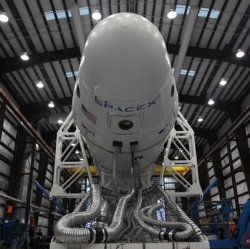
Elon Musk plans upgrades that could allow Dragons to fly 10 times without significant refurbishment. Musk doesn’t want SpaceX to simply become an orbital taxi service. His dreams are to transform the way in which space exploration is conducted, opening up the frontier to widespread affordable use.
Musk’s vision doesn’t end in Earth orbit but rather stretches all the way to the frozen deserts of Mars. The key is reusability. Musk said the crewed Dragon is designed to land softly back on Earth and be rapidly turned around for another flight, possibly on the same day.
"The reason that this is really important is that, apart from the convenience of the landing location, is that it enables rapid reusability of the spacecraft," Musk told the audience. Just reload the propellants and fly it again.
This is extremely important for revolutionizing access to space, because as long as we continue to throw away rockets and spacecraft, we will never have true access to space; it will always be incredibly expensive," he added. "You can imagine a scenario where … if an aircraft was thrown away after each flight, nobody would be able to afford to fly. Or very few, only a small number of government customers.
The same is true with rockets and spacecraft." If SpaceX’s engineers can pull it off, the crewed Dragon will launch on a Falcon 9 rocket that’s also fully reusable. This past April, the first stage of a Falcon 9 maneuvered to a soft "landing" on the ocean, refiring its engines and extending four landing legs before hitting the water intact. SpaceX’s goal is to to recover a Falcon 9 first stage with a touchdown on land by the end of the year.
The company would then re-launch the stage next year on a demonstration flight. The company’s engineers are also working on the more difficult problem of trying to recover the Falcon 9’s second stage, which reaches a much higher altitude. Musk predicted that instead of flying into space a handful of times per year as we do now, humans would eventually be able to fly to space multiples times per day.
"I think 20 years for thousands of flights," Musk said in response to a question about increasing annual launch rates. "And I think we could probably get to the hundreds-of-flights level in 12 to 15 years."
